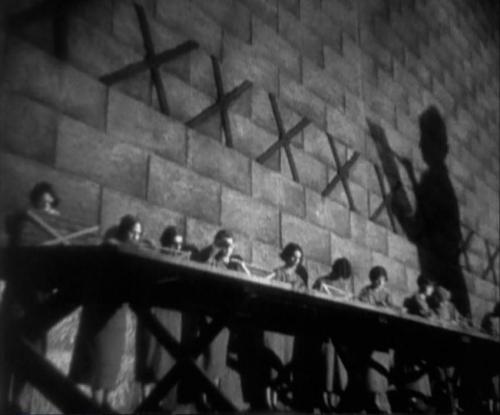
By Marilyn Ferdinand
When I affirmed I’d be part of this countdown, I sent a title to Sam to see if he thought it was appropriate for a film festival named for Allan. Sam, always the accommodating host at Wonders in the Dark, said, of course it was. I mulled that for some time until I realized I might be trying to school Allan from the other side of the pearly gates on films he generally overlooked in his expansive view of cinema (yes, we all have our blind spots). Following that realization, I looked for a different film, one on which Allan himself might have offered some pointed criticism that would make cinephilia a better place. I came up with Bedelia.
Allan showed some esteem for Bedelia’s director, Lance Comfort, whose Hatter’s Castle made his Movie Timeline for 1942. He also seems to have respected the talents of Margaret Lockwood, who plays the title character in Bedelia. He included her as a runner-up in two of his “Best of” lists, for supporting actress in The Stars Look Down (1939) and actress for The Man in Grey (1941). He had this to say about her in his review of 1939’s A Girl Must Live:
Lockwood had achieved stardom the previous year in The Lady Vanishes and (Carol) Reed’s Bank Holiday and this would be her second of four films for Reed – The Stars Look Down and Night Train to Munich would follow – and it’s fascinating to think of her playing the innocent ingénue only a few years before bitching up the screen in regency costume dramas.”
I wonder if Allan would have seen her mesmerizing performance in Bedelia as a warm-up for her imperious later roles. It certainly seems that way to me.
Lockwood plays Bedelia Carrington, the brand-new bride of Charlie Carrington (Ian Hunter), a middle-class Yorkshire building engineer. While on their honeymoon in Monte Carlo, they make the acquaintance of an artist, Ben Cheney (Barry K. Barnes), who arranges to chat them up at their fancy hotel—an extravagance for both men. Bedelia has been married before, to an emerging artist who died young. Ben promises Charlie to see if he can find a painting by Bedelia’s first husband—unaccountably, she has none of his works—and to look the couple up after all are back in England to finish a portrait of Bedelia Charlie commissioned in Monte Carlo. This he does, also bringing a painting bearing her late husband’s signature to a Christmas party hosted by the Carringtons. That very evening, Charlie falls very ill and hovers near death for weeks. His slow, steady recovery under the watchful eye of a private-duty nurse (Jill Esmond), however, seems to make Bedelia more and more anxious. It’s only a matter of time until her dark secret leads to a strangely compassionate conclusion.
We learn in the opening frames that Bedelia is some kind of wicked enchantress, as a voiceover by Ben reveals her peculiar nature as we gaze at a pretty crummy painting of the ravishingly beautiful woman. To its credit, however, the film maintains an admirable suspense, allowing Lockwood to build a character who keeps us off-balance—a gorgeous woman who, like Rita Hayworth, is more than the sum of her hair tosses. We know she is hiding something when she lies to her husband, but she seems absolutely besotted with him. We know she doesn’t like to be photographed or drawn, but she agrees, albeit reluctantly, to allow Ben to paint her portrait. We feel the same revulsion toward Ben that she does; he appears to be watching Bedelia, questioning a jeweler about a pearl she brought in to be reset, and he rents a dog to get Bedelia to talk to him.

Ian Hunter is an excellent foil for Lockwood. Playing a doting husband with a welcoming sense of humor, he is completely natural in his relationship with Bedelia—including standing up to her when she makes what he considers to be unreasonable demands. He’s not a clueless dupe, and his love and equanimity with her has us believing Bedelia’s declaration that he is different from any other man she’s met. Equally, Barnes isn’t afraid to behave like an aggressive cad who works hard—maybe too hard—to throw Bedelia off her game. A great supporting cast fills out this film that is more than a mystery; it’s a finely wrought melodrama about the complicated nature of love, hate, and the drive for freedom.
Bedelia derives from a novel by Vera Caspary, whose novel Laura formed the basis for one of cinema’s most famous and acclaimed noir films. Caspary, a successful author of murder mysteries, collaborated on the screenplay for Bedelia, an apprenticeship in the art of writing for film that would eventually win her accolades from the Writers Guild of America for A Letter to Three Wives (1950). The film might have reached the heights of Laura (1944), whose opening it mimics, if it had been made on a Hollywood budget, not the shoestring that usually attended productions by British National Films (BNF), a company that went belly-up only two years after Bedelia was released. But no expense was spared in dressing Lockwood, whose allure is essential to the effectiveness of the film; I don’t think I saw her wear anything more than once in any scene, not even her robe.
Bedelia is not perfect or terribly stylish, but its psychological complexity and some of its plot points are echoed in some of the world’s greatest films, including Hitchcock’s Vertigo (1958). I’d like to think that Bedelia is a film Allan would have appreciated.
You can view Bedelia on YouTube here: https://www.youtube.com/watch?v=v7WPeJRXaF0
Read Full Post »





































 Click on names for archives
Writers/Founders
Click on names for archives
Writers/Founders